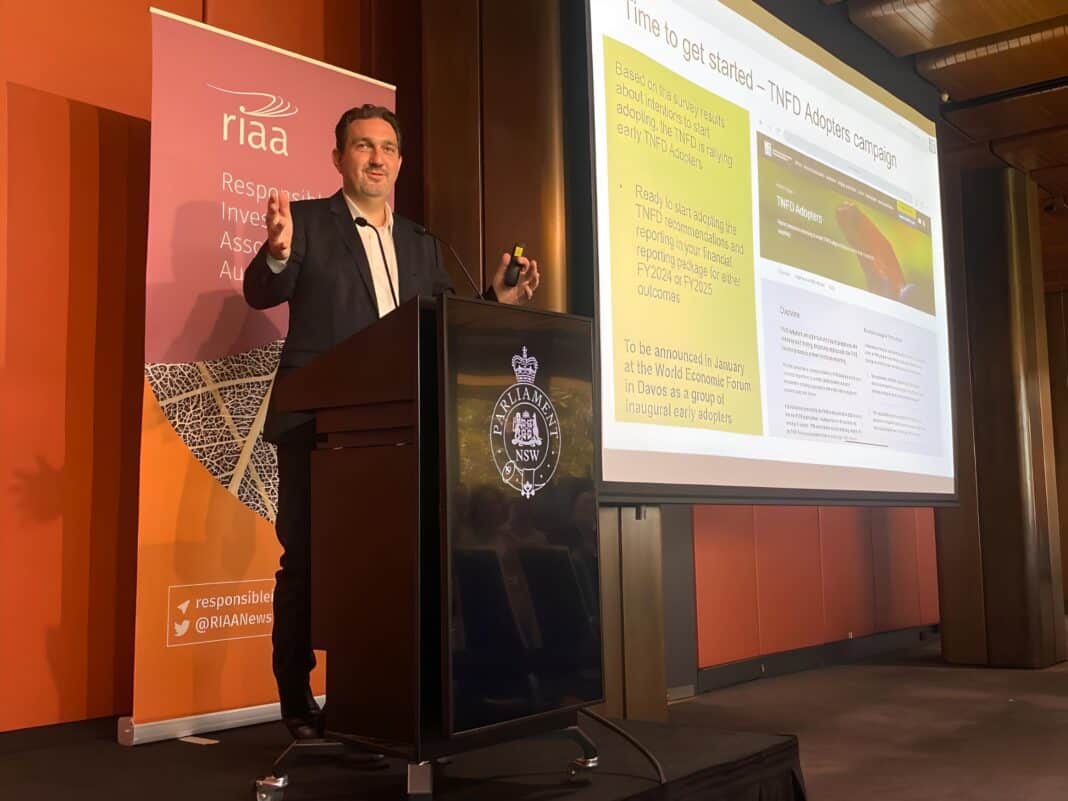The Australian Big Four Banks, Macquarie, and 40 of the world’s largest financial institutions are behind a new standard to make financial investment ‘nature positive.’
They are pushing the Australian Government to include the new standard in the soon-to-be-released “sustainable finance” agenda.
Backing a new set of guidelines released at the UN Climate Week in New York City yesterday, the banks want full disclosure of impacts on the natural environment.
In addition, they are demanding action on biodiversity, deforestation and land clearing as part of a general push to ensure that nature “is considered alongside financial, operational and climate risks.”
The global pact, which forms part of the Taskforce on Natural Related Financial Disclosure (TFND), represents more than US $20 trillion (or AU $31 trillion) of assets under management and is already investing heavily in ‘spatial finance.’
Under the new guidelines, financial institutions will assess biodiversity impacts and dependencies as part of the Location, Evaluate, Assess and Prepare approach.
Known as the ‘LEAP framework,’ Wood Central can reveal that Australian banks use satellite mapping technology to determine the boundaries of properties they are funding and to see the impact of land clearing or water use on land.
As reported in the Australian Financial Review, the Commonwealth Bank of Australia, ANZ, Rabobank, and ING are all working with start-up Digital Agriculture Services to map the boundary lines of every rural property in Australia, with the Australian Conservation Foundation pushing to go further.
“The key for business is to use the work on the climate disclosure to build up / accelerate nature,” according to Andrew Peterson, who spoke to FS Sustainability’s Rose Mary Petrass and Rachel Alembakis.
Mr Peterson is the CEO of the Business Council for Sustainable Development in Australia and said that more than 200 US companies have already participated in the pilot.
Its impact on the forest industry is unknown; however, the Wood Central Publisher spoke to an Australian-based industry association claiming that members could not obtain finance due to “ESG” concerns.
The authors behind the new guidelines claim that more than 1200 institutions from 58 countries participated in the development, with the framework now expected to be integrated into accounting standards via the International Sustainability Standards Board.
The Global Reporting Initiative uses them and could be incorporated into the new European Sustainability Reporting Standards.
TFND co-chair David Craig said businesses are “inadequately accounting for nature-related dependencies, impacts, risks and opportunities.”
Mr Craig said the cost of inaction is mounting quickly, with “nature-risk siting in company cash flows and capital portfolios.”
They are part of a more significant shift by global financial markets away from companies that cause environmental damage with a pivot to invest in creating “nature-positive outcomes.”
French President Emmanuel Macron are among the global leaders who have welcomed the new standards.
“Nature provides irreplaceable services to societies and businesses,” he said. “I applaud the TNFD’s efforts in publishing today a framework that can be utilised to identify, assess, manage and disclose dependencies and impacts on nature, as well as risks and opportunities for organisations.”
The new standards will see banks invest more to offset the impact of biodiversity loss or land clearance from activities within their lending portfolios.
Responsible Investment Association of Australasia CEO Simon O’Connor told the Australian Financial Review that the Australian economy was highly dependent on nature, and banks needed to “understand the exposure and dependencies in their lending books or portfolios, as a starting point for managing those risks”.
The task will be more challenging than carbon, which has a standard measure for emissions, Mr O’Connor said.
In contrast, nature is location-specific and relates to wide-ranging activities, from deforestation to protecting particular species.
“So a spatial understanding of assets is a critical part of strong oversight of where and how nature risks could impact a business.”
“Already, leading banks are working to understand how well different agricultural clients are managing nature and biodiversity – from soil to water to broader biodiversity – and as part of this, a better understanding of the location of clients will be a critical element of understanding those risks.”
In May, the Wood Central Publisher attended the Responsible Investment Australia 2023 conference, the largest responsible investment conference in the southern hemisphere.
Despite its significant contribution to sustainability, he reported that the forestry sector was underrepresented in the discussions.
“This shows the need for the industry to communicate its role in the sustainability transition more effectively. The industry needs to articulate better the benefits of carbon sequestration and the production of carbon-dense products,” the publisher said.
FS Sustainability reports that the scale of nature loss, reported by the WWF to cost the Australian economy US $20 billion by 2050, is among the drivers of the push.
“Nature loss needs to be arrested urgently,” ACSI CEO Louise Davidson said.
“Ecosystems are enormously complex, and when they are impacted, repercussions are felt at multiple levels and can be cumulative.”
“The challenge is even greater due to a lack of detailed and high-quality information about how individual companies impact nature,” she said.
“The release of the TNFD recommendations will give companies a foundation to measure their impacts and dependencies on nature and their key risks, and we expect companies to improve mitigation and risk management.”
“The TNFD will also afford investors global comparability, which will be welcome.”
“The complexity of the issues means there will be a steep learning curve for all of us when managing and mitigating nature-related risks.
“Still, with so much at stake, we have no choice but to get moving and rapidly build capacity and capability.”






